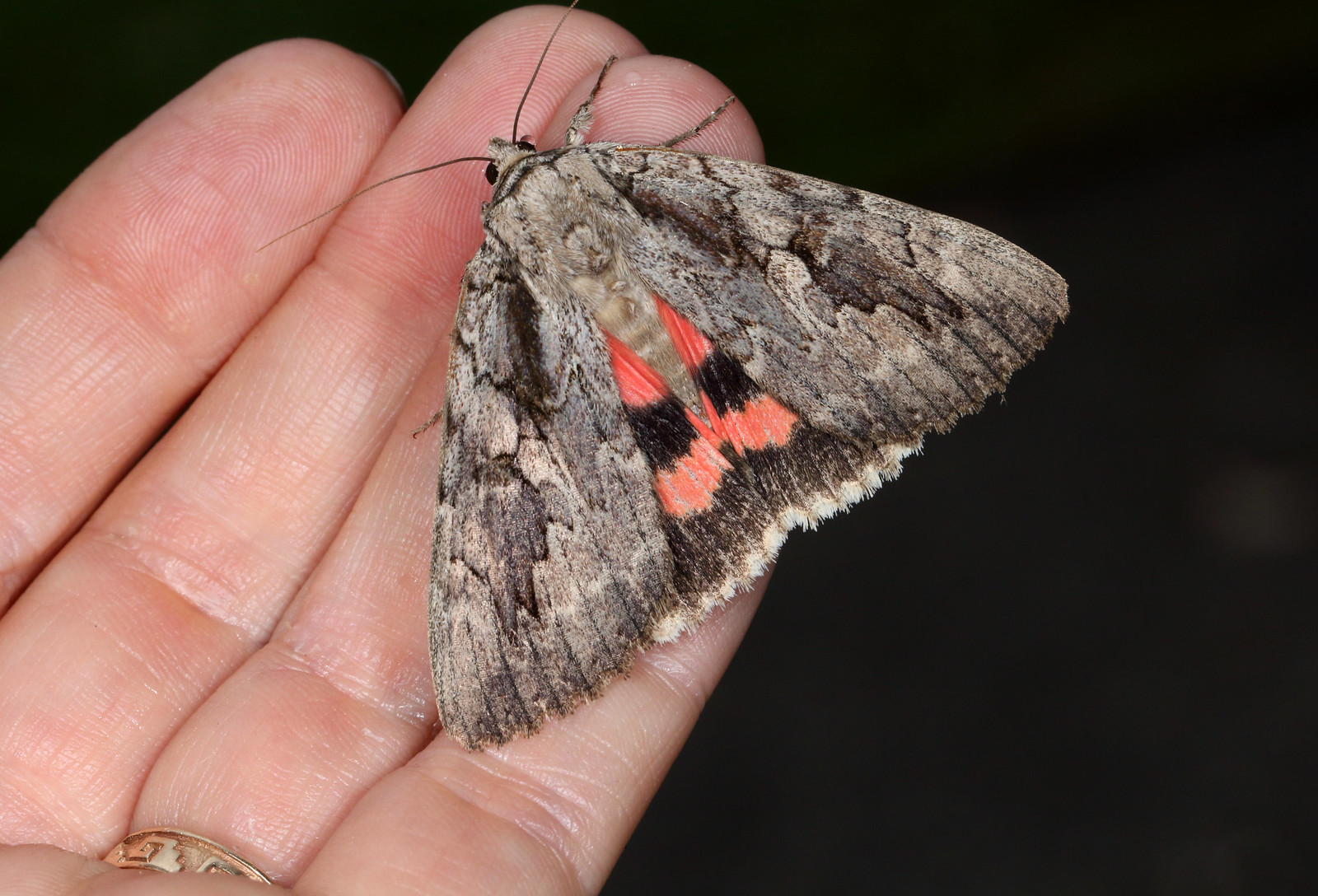More from September-ish
Aug 2, 2020 10:49:41 #
More pictures from late last year. September, I think.
First up is one of the buffalo treehopper species. This is Strictocephala diceros. Buffalo treehoppers can be very wily! When you even look at them, they can quickly move to the opposite side of the plant stem.
 Buffalo treehopper by Mark Sturtevant, on Flickr
Buffalo treehopper by Mark Sturtevant, on Flickr
Next is our six-spotted fishing spider (Dolomedes triton). I photographed the heck out of these aquatic spiders earlier in the season. This is a youngster, not even half-way grown, but she has done well to catch a damselfly. The younglings will over-winter and appear early next season as adults.
 Six-spotted fishing spider by Mark Sturtevant, on Flickr
Six-spotted fishing spider by Mark Sturtevant, on Flickr
The cricket shown here is the red-headed bush cricket (Phyllopalpus pulchellus). The interesting story is that they used to live farther south, but they have been moving northward.
 Red-headed bush cricket by Mark Sturtevant, on Flickr
Red-headed bush cricket by Mark Sturtevant, on Flickr
This is a nymph of the helmeted squash bug (Euthochtha galeator). I like the spikeyness, although the adult is unremarkable and I have not photographed it yet. This picture is a stacked image of two pictures that were taken by hand. Considerable additional work in Gimp was required since both antennae and a couple legs had to be moved because the stack did not align well. Why did I bother? I don’t know.
 Helmeted squash bug nymph by Mark Sturtevant, on Flickr
Helmeted squash bug nymph by Mark Sturtevant, on Flickr
Next is a thread-waisted wasp, but I am not sure about the species. We have Ammophila procera, which is a similar but larger species that was shown here earlier, but I don’t see the long mandibles that the females use to carry paralyzed caterpillars. So maybe this is a male A. procera. An inquiry has been sent to BugGuide, and I am sure they are right now working hard to provide an answer. In any case, it was sound asleep and had secured itself to the plant by locking its jaws on it. These wasps are normally very active, but sleeping ones are a piece of cake.
 Sleeping thread-waisted wasp by Mark Sturtevant, on Flickr
Sleeping thread-waisted wasp by Mark Sturtevant, on Flickr
One day in a park I was chased out of the field by a sudden rain shower. While sitting it out under a picnic shelter, I noticed this large underwing moth near the ceiling so I climbed up to retrieve it for pictures. Hard to identify the species exactly as there are so many of them from this group, but it looks like Catocala amatrix.
 Underwing moth by Mark Sturtevant, on Flickr
Underwing moth by Mark Sturtevant, on Flickr
I had learned that “Catocala” is Greek for ‘beautiful below’, which refers to the flashy hind wings of underwing moths. This large genus of moths utilizes a combination of camouflage and deception to thwart predators. When disturbed to take flight, they are super speed demons and they fly very evasively so no bird in existence can even hope to chase it. But one can plainly see its flashing colors when flying, and that is what a predator will then remember to search for when it lands. It lands on vertical surfaces (which are supposed to be tree trunks not picnic shelters), often quickly scooching to the opposite side of the tree trunk before settling. With the wings folded, it can generally blend in perfectly with the bark. A predator would be looking for something brightly colored here, and would not be even thinking to look for a bit of “tree bark” over there.
I remember a few years ago when I spotted one of these on a tree trunk (it was not a good match where it settled). I spent considerable time taking pictures, and when viewing them in the computer only then did I notice another one sitting mere inches away!
Finally, I picked up a bunch of monarch caterpillars (Danaus plexippus), and raised them. I wanted to photograph the changes in the chrysalis as the adult starts to form inside, and to maybe photograph an emergence. But I got distracted (goofing off outdoors with the camera, no doubt), and so managed to miss most of it. But this is some of what I got. ¯\_(ツ)_/¯
 Monarchs pupating by Mark Sturtevant, on Flickr
Monarchs pupating by Mark Sturtevant, on Flickr
 Monarch chrysalis by Mark Sturtevant, on Flickr
Monarch chrysalis by Mark Sturtevant, on Flickr
 Monarch chrysalis by Mark Sturtevant, on Flickr
Monarch chrysalis by Mark Sturtevant, on Flickr
 Monarch butterfly by Mark Sturtevant, on Flickr
Monarch butterfly by Mark Sturtevant, on Flickr
First up is one of the buffalo treehopper species. This is Strictocephala diceros. Buffalo treehoppers can be very wily! When you even look at them, they can quickly move to the opposite side of the plant stem.
 Buffalo treehopper by Mark Sturtevant, on Flickr
Buffalo treehopper by Mark Sturtevant, on FlickrNext is our six-spotted fishing spider (Dolomedes triton). I photographed the heck out of these aquatic spiders earlier in the season. This is a youngster, not even half-way grown, but she has done well to catch a damselfly. The younglings will over-winter and appear early next season as adults.
 Six-spotted fishing spider by Mark Sturtevant, on Flickr
Six-spotted fishing spider by Mark Sturtevant, on FlickrThe cricket shown here is the red-headed bush cricket (Phyllopalpus pulchellus). The interesting story is that they used to live farther south, but they have been moving northward.
 Red-headed bush cricket by Mark Sturtevant, on Flickr
Red-headed bush cricket by Mark Sturtevant, on FlickrThis is a nymph of the helmeted squash bug (Euthochtha galeator). I like the spikeyness, although the adult is unremarkable and I have not photographed it yet. This picture is a stacked image of two pictures that were taken by hand. Considerable additional work in Gimp was required since both antennae and a couple legs had to be moved because the stack did not align well. Why did I bother? I don’t know.
 Helmeted squash bug nymph by Mark Sturtevant, on Flickr
Helmeted squash bug nymph by Mark Sturtevant, on FlickrNext is a thread-waisted wasp, but I am not sure about the species. We have Ammophila procera, which is a similar but larger species that was shown here earlier, but I don’t see the long mandibles that the females use to carry paralyzed caterpillars. So maybe this is a male A. procera. An inquiry has been sent to BugGuide, and I am sure they are right now working hard to provide an answer. In any case, it was sound asleep and had secured itself to the plant by locking its jaws on it. These wasps are normally very active, but sleeping ones are a piece of cake.
 Sleeping thread-waisted wasp by Mark Sturtevant, on Flickr
Sleeping thread-waisted wasp by Mark Sturtevant, on FlickrOne day in a park I was chased out of the field by a sudden rain shower. While sitting it out under a picnic shelter, I noticed this large underwing moth near the ceiling so I climbed up to retrieve it for pictures. Hard to identify the species exactly as there are so many of them from this group, but it looks like Catocala amatrix.
 Underwing moth by Mark Sturtevant, on Flickr
Underwing moth by Mark Sturtevant, on FlickrI had learned that “Catocala” is Greek for ‘beautiful below’, which refers to the flashy hind wings of underwing moths. This large genus of moths utilizes a combination of camouflage and deception to thwart predators. When disturbed to take flight, they are super speed demons and they fly very evasively so no bird in existence can even hope to chase it. But one can plainly see its flashing colors when flying, and that is what a predator will then remember to search for when it lands. It lands on vertical surfaces (which are supposed to be tree trunks not picnic shelters), often quickly scooching to the opposite side of the tree trunk before settling. With the wings folded, it can generally blend in perfectly with the bark. A predator would be looking for something brightly colored here, and would not be even thinking to look for a bit of “tree bark” over there.
I remember a few years ago when I spotted one of these on a tree trunk (it was not a good match where it settled). I spent considerable time taking pictures, and when viewing them in the computer only then did I notice another one sitting mere inches away!
Finally, I picked up a bunch of monarch caterpillars (Danaus plexippus), and raised them. I wanted to photograph the changes in the chrysalis as the adult starts to form inside, and to maybe photograph an emergence. But I got distracted (goofing off outdoors with the camera, no doubt), and so managed to miss most of it. But this is some of what I got. ¯\_(ツ)_/¯
 Monarchs pupating by Mark Sturtevant, on Flickr
Monarchs pupating by Mark Sturtevant, on Flickr Monarch chrysalis by Mark Sturtevant, on Flickr
Monarch chrysalis by Mark Sturtevant, on Flickr Monarch chrysalis by Mark Sturtevant, on Flickr
Monarch chrysalis by Mark Sturtevant, on Flickr Monarch butterfly by Mark Sturtevant, on Flickr
Monarch butterfly by Mark Sturtevant, on FlickrAug 2, 2020 11:18:12 #
Aug 2, 2020 11:18:36 #
Aug 2, 2020 11:19:32 #
Aug 2, 2020 15:04:02 #
Mark Sturtevant wrote:
More pictures from late last year. September, I th... (show quote)
Fine photos.
One question.
Are the two chrysalyds on a cherry twig?
Cherry is not a preferred food plant, but who knows?
Bill
Aug 2, 2020 15:07:48 #
newtoyou wrote:
Fine photos.
One question.
Are the two chrysalyds on a cherry twig?
Cherry is not a preferred food plant, but who knows?
Bill
One question.
Are the two chrysalyds on a cherry twig?
Cherry is not a preferred food plant, but who knows?
Bill
Good thinking! The cats would crawl off of their food plant in a bug cage, and start to pupate in at the top of the cage. I would carefully pick them off along with the silk pad that they made and glue them to a twig which I guess was cherry. You can see the silk pads are pretty gummy looking.
Aug 2, 2020 15:22:43 #
Mark Sturtevant wrote:
Good thinking! The cats would crawl off of their food plant in a bug cage, and start to pupate in at the top of the cage. I would carefully pick them off along with the silk pad that they made and glue them to a twig which I guess was cherry. You can see the silk pads are pretty gummy looking.
Yep, have resorted to that. As the chrysalis must hang free, they may die before eclosing, it was necessary.
Bill
Aug 3, 2020 06:08:58 #
Aug 3, 2020 07:27:42 #
Aug 3, 2020 08:17:05 #
Outstanding set Mark. Every shot sharp and well lighted. Great narrative. Well done.
-Doc
-Doc
Aug 3, 2020 09:50:43 #
Aug 3, 2020 10:20:05 #
Aug 3, 2020 10:26:48 #
Aug 3, 2020 23:36:38 #
If you want to reply, then register here. Registration is free and your account is created instantly, so you can post right away.










